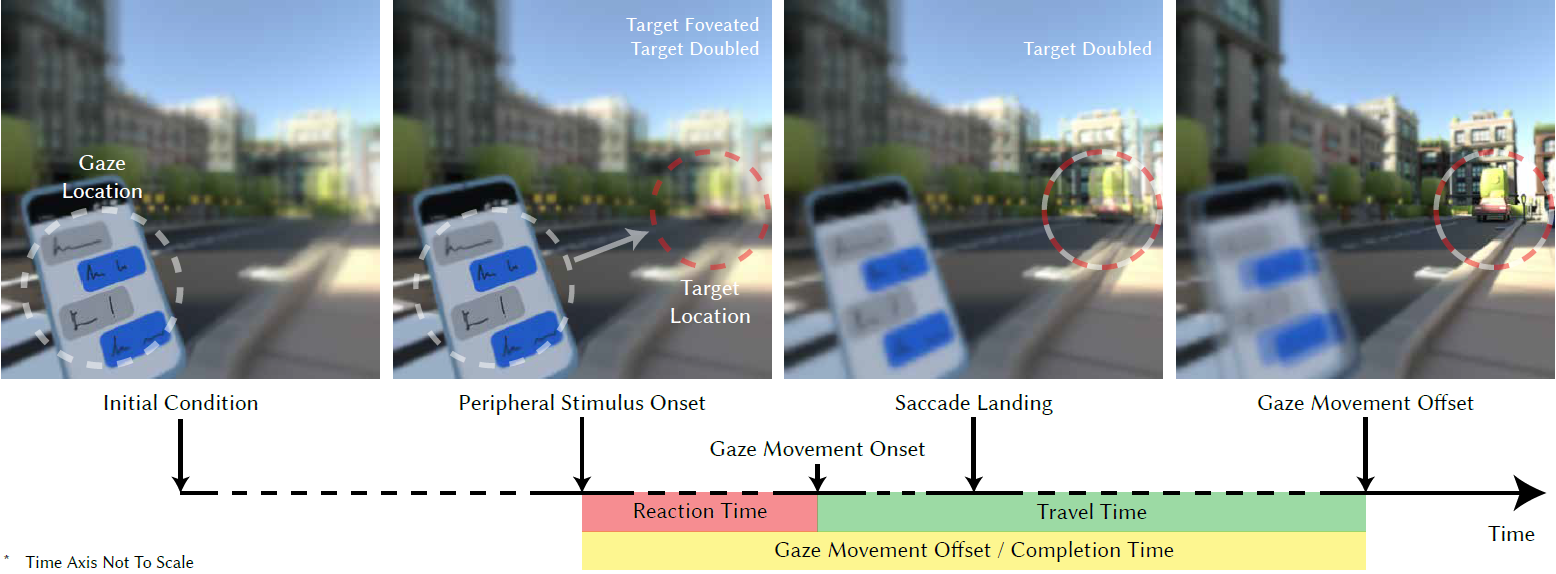The Shortest Route Is Not Always the Fastest: Probability-Modeled Stereoscopic Eye Movement Completion Time in VR

Our model predicts the completion time of stereoscopic eye movement toward a target in the visual field. It provides a probability distribution of the duration between the onset of the target and the first moment we can see it in a clear, unfoveated manner, accounting for both saccadic and vergence changes necessary to do so. (a) When users focus their gaze on a specific 3D target, objects at a different depth appear doubled (due to incorrect vergence), blurred (due to peripheral vision), or both. (b) A peripheral target might trigger a gaze movement of both the left and right eyes, which initiates after a reaction time necessary for cognitive processing. (c) First, the conjugate and ballistic saccadic movement lands the target into foveal vision with high acuity; but we may still see double vision due to the slower, incomplete vergence movement. (d) Once the disconjugate vergence movement also completes, we can successfully fuse the stereoscopic imagery and see the target clearly.
Abstract
Speed and consistency of target-shifting play a crucial role in human ability to perform complex tasks. Shifting our gaze between objects of interest quickly and consistently requires changes both in depth and direction. Gaze changes in depth are driven by slow, inconsistent vergence movements which rotate the eyes in opposite directions, while changes in direction are driven by ballistic, consistent movements called saccades, which rotate the eyes in the same direction. In the natural world, most of our eye movements are a combination of both types. While scientific consensus on the nature of saccades exists, vergence and combined movements remain less understood and agreed upon.
We eschew the lack of scientific consensus in favor of proposing an operationalized computational model which predicts the completion time of any type of gaze movement during target-shifting in 3D. To this end, we conduct a psychophysical study in a stereo VR environment to collect more than 12,000 gaze movement trials, analyze the temporal distribution of the observed gaze movements, and fit a probabilistic model to the data. We perform a series of objective measurements and user studies to validate the model. The results demonstrate its predictive accuracy, generalization, as well as applications for optimizing visual performance by altering content placement. Lastly, we leverage the model to measure differences in human target-changing time relative to the natural world, as well as suggest scene-aware projection depth. By incorporating the complexities and randomness of human oculomotor control, we hope this research will support new behavior-aware metrics for VR/AR display design, interface layout, and gaze-contingent rendering.
Introduction Video
Citation
Budmonde Duinkharjav, Benjamin Liang, Anjul Patney, Rachel Brown, Qi Sun
The Shortest Route Is Not Always the Fastest: Probability-Modeled Stereoscopic Eye Movement Completion Time in VR.
ACM Transactions on Graphics 42(6) (Proceedings of ACM SIGGRAPH Asia 2023)
BibTeX
Downloads
Paper
Supplementary Material
Code and Data Coming Soon!
Acknowledgements
We would like to thank Avigael Aizenman and Agostino Gibaldi for insightful advice on processing stereo gaze data, and support in leveraging the video game gaze behavior data in their work [Aizeman et al. 2022]. This project is partially supported by the National Science Foundation grants #2225861 and #2232817, and a DARPA PTG program.